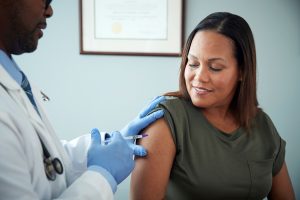Topics on Women’s Health
We Need to Talk About Miscarriage
Talking gives us more information and less stigma.
Lindsey Davis, MD, MPH
ChristianaCare Obstetrics and Gynecology

Miscarriage is a topic that used to be discussed only in whispers, if at all. But it’s a conversation that deserves to be heard, considering that up to 20% of all early pregnancies end in a miscarriage.
We need to talk more about the frequency of miscarriage for several important reasons, but especially to reduce the stigma around patients who experience this kind of loss. They need our support to strengthen their physical, emotional and psychological health as they recover. Learning more about miscarriage can help.
What Is a Miscarriage?
Miscarriage refers to any spontaneous pregnancy loss under 20 weeks of gestational age. The American College of Obstetricians and Gynecologists estimates it’s the most common form of pregnancy loss, with the majority of miscarriages occurring in the first trimester. Although fears of miscarriage are common among patients in their first trimester, the good news is that risk of pregnancy loss decreases after 12 weeks gestation.
Why Does Miscarriage Happen?
Most early pregnancy losses occur because of abnormalities in the development of the fetus, such as too many or too few chromosomes. These irregularities, which usually happen spontaneously, make it impossible for the fetus to develop normally. In these cases, nothing can be done to prevent a miscarriage from occurring.
Some situations, such as increasing maternal age, can increase the risk of chromosomal abnormalities that can lead to miscarriage. Uncontrolled health conditions in the mother, like diabetes or thyroid levels, also can increase the risk of miscarriage.
Patients who might be at higher risk should consult with their health care provider to better assess their individual situation. Exercise, sexual activity or working — as long as you aren’t exposed to environmental hazards — cannot cause a miscarriage.
Most patients who experience a miscarriage later go on to have a successful pregnancy. In rare cases, some women experience recurrent miscarriages — defined as having more than three miscarriages.
These patients should seek the help of a specialist for additional testing to help identify any underlying causes and potential treatment options to increase the odds of a successful pregnancy.
What Are the Symptoms?
Pregnancy can bring on episodes of pain and discomfort, but ongoing cramping or bleeding for a patient with a confirmed pregnancy can indicate a potential miscarriage. Visiting a healthcare provider may be a good idea if you’re experiencing vaginal spotting, bleeding, pain in the abdomen or pain in the lower back.
A provider may order a blood test to check the level of pregnancy hormones and compare it against earlier levels. They also may check for a fetal heartbeat and look at development of the embryo using ultrasound. Although it’s understandable that individuals want immediate answers, that isn’t always possible. It can take as long as a week to determine if hormone levels are rising or the embryo’s structures are developing appropriately.
Once a miscarriage has been confirmed, patients have some options about how they want to proceed. One option is to let the miscarriage progress naturally and let the body pass the fetal tissue on its own. Patients can experience significant bleeding for a few weeks, which can be emotionally and physically painful for a grieving parent. And there’s also a risk of an infection developing if abnormal pregnancy tissue remains inside the uterus for an extended time.
In some cases, the process can be shortened through medication that helps the body clear the residual tissue in a few days. For other patients, a surgical intervention may be chosen or needed to completely remove the fetal tissue.
There’s no simple answer for how to manage a miscarriage. It’s a painful time, both physically and emotionally. However a patient chooses to manage a miscarriage, she should have the support of her provider and loved ones.
Dealing with Pregnancy Loss
There are a lot of questions about miscarriage, both from patients and the people who care about them. Family members and friends understandably want to know what they should do and how they can support someone who’s lost a pregnancy.
I don’t have all the answers, but I tell my patients that what they’ve experienced is a true loss. They should take time for grieving just as they would for any other loss. Some will accept the non-viability of the pregnancy quickly. Others will grieve the loss of what could have been. In either case, it’s a painful experience.
Family members and loved ones should be aware that after a miscarriage, they should be sensitive to the emotional and physical triggers that may surround the grieving parent. A good resource to check out is Share (NationalShare.org), a website for anyone who has experienced pregnancy loss.
When it comes to contemplating a future pregnancy, the decision of when to resume trying to conceive is up to the patient and their partner. Some people need more time and space before they’re ready to prepare for another pregnancy. From a physical standpoint, a woman can safely conceive after having at least one normal menstrual cycle, as long as there aren’t any other uncontrolled chronic medical illnesses. But it can take anywhere from two to 12 weeks after the miscarriage for a menstrual cycle to return following a pregnancy.
Miscarriage brings many questions for expectant parents. Yet often, there are few answers. The more we honor these experiences and their impact on people, the better we can care for our patients and those we love.
 Lindsey Davis, MD, MPH, specializes in obstetrics and gynecology at ChristianaCare. She has expertise in preventive care, menopause and pregnancy and helps women have healthy and safe pregnancies. Dr. Davis sees patients at ChristianaCare’s Concord, Kennett Square and Greenville locations and delivers babies at the state-of-the-art Center for Women’s & Children’s Health on the ChristianaCare Newark Campus.
Lindsey Davis, MD, MPH, specializes in obstetrics and gynecology at ChristianaCare. She has expertise in preventive care, menopause and pregnancy and helps women have healthy and safe pregnancies. Dr. Davis sees patients at ChristianaCare’s Concord, Kennett Square and Greenville locations and delivers babies at the state-of-the-art Center for Women’s & Children’s Health on the ChristianaCare Newark Campus.
HPV Vaccine
It’s not just for teen girls
Jessica Mayer, DO, Family Medicine Department Chair
Suburban Family Medicine Residency
As doctors look to keep our patients healthy and thriving beyond the past years’ pressing concerns from Covid-19, we’re fortunate to have many tools to treat and prevent disease. As a family medicine physician, I find that cancer prevention is one of the important parts of my patients’ ongoing care.
Some Background
Fortunately, we have an array of very safe and effective preventive treatments to help address cancer. Among those is a vaccine that protects against the sequela of human papillomavirus (HPV) infections, which can develop into cancer.
HPV is a sexually transmitted organism that can cause multiple types of cancer as well as problematic warts. According to the Centers for Disease Control and Prevention, it’s the most common sexually transmitted infection (STI, about 43 million infections in 2018) in the U.S. and can spread easily.
Too often, individuals don’t know they’re infected with HPV and can unknowingly pass it along to their partners. You can develop symptoms years after having sex with someone who had the infection.
It’s important to note that HPV infections are not limited to the cervix alone but can also affect the vagina, penis, vulva and throat. This means the important responsibility of preventing the spread of HPV applies to all individuals.
Initially, the HPV vaccine was given only to adolescent girls. Now the guidelines for the use of the HPV vaccine have been updated to include both broader age and gender categories.
Who Should Get the HPV Vaccine?
As a result of extensive research and data review, the Advisory Committee on Immunization Practices has updated its guidelines surrounding the administration of the HPV vaccines. The most recent guidelines have changed to include a more comprehensive age range of adults. These vaccines are sold in the U.S. under the names Cervarix, Gardasil and Gardasil 9.
The HPV vaccine can be administered to those as young as age 9, although it’s typically given starting at ages 11–12. If individuals get the vaccine before age 15, they need only two doses to be fully protected, as their immune system develops a very robust response.
A three-dose series of vaccinations is recommended for older teens and adults to be fully protected. At all ages, the series can be completed in a 6-month timeframe and does not need to be restarted if doses are spread out over a longer period. The shots are generally administered in the upper arm or upper leg.
The HPV vaccine is recommended for any adult up to age 26 who has not already been fully immunized. This recommendation is made for all adults regardless of gender, risk factors or sexual activity and practices.
Currently, the vaccine is not approved to be given to those over 45. And for adults ages 27 to 45, the decision about getting the vaccine should be a joint discussion with your primary care provider.
Factors to Consider for Those 27 to 45
When deciding if it makes sense for someone over 26 to receive the HPV vaccine, several factors should be considered.
Most sexually active adults have already been exposed to HPV, although they have likely not been exposed to all the strains of the virus the vaccine covers. Consequently, there’s still a benefit for individuals to receive the vaccine after they’ve become sexually active.
For individuals currently in long-term mutually monogamous relationships, the benefits of receiving the vaccine may be minimal. But for an individual who anticipates having at least one new sexual partner, there can be a significant benefit to getting the vaccine.
It’s essential to have a candid conversation with your primary care physician to discuss your individual needs.
What the Vaccine Does (and Doesn’t) Do
The HPV vaccine provides protection against multiple strains of HPV. Some strains are known to cause cancer of not only the cervix but also other genital regions and the mouth and throat.
Additionally, the vaccine provides protection against warts, which can occur in multiple genital locations as well.
The vaccine is preventative and cannot treat any existing HPV infections or benefit an existing wart or cancer. While the vaccine can be given after an identified HPV infection, it will not provide any treatment benefit for any current conditions. And it will not protect you against other sexually transmitted infections not caused by HPV, such as HIV or HSV (herpes).
It’s still important to get the vaccine to prevent future infections with other strains.
More Prevention
Regardless of an individual’s choice about receiving the HPV vaccine, cervical cancer screening remains an important part of cancer detection and prevention.
For most individuals over 21, cervical cancer screening is recommended every 3 to 5 years. It’s important to talk with your primary care physician about the screening schedule that is right for you.
Regular cervical cancer screening through pap testing is an important way to catch early signs of cellular changes that are cancerous or could lead to cancer. Catching these changes early can often allow minimally invasive treatments to resolve the issue altogether.
Final Words
While HPV is a very common and dangerous virus, we’re fortunate to have a vaccine that can prevent its spread and transmission. Discussing the HPV vaccine with your primary care physician can be very beneficial in avoiding infection and cancer.
 Jessica Mayer is a board-certified physician specializing in family medicine and is the Program Director of the Suburban Family Medicine Residency program and Vice-Chair of the Family Medicine Department at Suburban Community Hospital. She received her medical degree from the Philadelphia College of Osteopathic Medicine, held an internship at Crozer-Chester Medical Center in Pennsylvania, and completed a residency at Mercy Suburban Hospital in Philadelphia.
Jessica Mayer is a board-certified physician specializing in family medicine and is the Program Director of the Suburban Family Medicine Residency program and Vice-Chair of the Family Medicine Department at Suburban Community Hospital. She received her medical degree from the Philadelphia College of Osteopathic Medicine, held an internship at Crozer-Chester Medical Center in Pennsylvania, and completed a residency at Mercy Suburban Hospital in Philadelphia.
What Women 65+ Should Look For in a Primary Care Practitioner
How to find the right fit
Kathy Hill, NP, PCP
Primary Care Practitioner at Patina

Choosing a primary care practitioner (PCP) is a major health decision. It’s highly personal, too. This health practitioner will make a big impact not just on your access to care but on your quality of life.
For women 65+ in particular, there are considerations to weigh during the process of choosing the right provider. Your PCP should be an anchor in your aging experience, helping you achieve your health goals, anticipate normal changes and address unique challenges.
It’s crucial to take time to think through questions around healthcare philosophies, relationship building, convenience and logistics. Here are a few key considerations for women 65+ to keep top of mind, to ensure you get the healthcare and aging experience you want and deserve.
A Focus on Older Adults
As people age, their care needs change. New issues pop up. Health topics that once seemed far off, like bone density, can grow in importance. And issues present themselves differently in older adults. For example, symptoms like fatigue or loss of appetite can be warning signs for bigger issues, such as an infection or heart disease.
Older adult care requires a specific skill set, making it important to look for a PCP with deep experience working with 65+ adults. Practices that serve only 65+ adults are more likely to offer another benefit beyond knowledge and experience — a team with a passion for caring for older adults.
What don’t you want? Someone who doesn’t take your input seriously and is quick to assume your health conditions are just related to being older.
But knowing older adults overall isn’t enough. You want a PCP who will put in the time to get to know you and your unique health needs, preferences and goals. For instance, this approach is a unique part of care at my primary care practice at Patina, available in the greater Philadelphia area. After our patients’ first visit, I make sure they feel seen and heard, have a care plan, and understand what’s going to happen next and who to contact for any questions.
Whole-Person Care
Older women have specific health needs. Women 65 and up should look for a practitioner with experience treating women’s health changes and issues, such as care after menopause, including osteoporosis and bladder and sexual health. But that’s just the beginning.
Your primary care provider should treat you in your entirety, delivering personalized, coordinated care for a range of medical, behavioral health, social care and logistical needs. That takes a provider that offers not only an individual PCP, but ideally a primary care team that stays with you over time and addresses your whole-person needs.
For example, your care team may include your PCP, who guides your care, plus an individual who helps you navigate your care — from helping you schedule specialist appointments, to setting up transportation, if needed, and other legwork.
Specialized resources should also be available, including mental and behavioral care practitioners. You should be able to include family and loved ones in your care, making it easy for everyone to stay informed.
And you should be the leader of your care, supported by a care team who takes the time to know you and build trusted relationships.
PCP’s Care Philosophies
Different providers have different philosophies for care. It’s important for women 65 and older to understand the care philosophies of potential providers and share that vision for care. It builds trust.
Key decisions like courses of treatment, frequency of visits and involvement of family or friends can be a direct result of a practitioner’s approach. When patients trust their PCP’s perspectives, they are more likely to follow recommended treatments. A shared philosophy can also help prevent miscommunications and help older adults make more informed care decisions.
While a shared vision is key, keep in mind that decisions are best made by patients, not providers. You don’t want someone who picks priorities for you. Be honest about what’s really important to you, especially as you age.
Consider Logistics
Your healthcare should accommodate you. Location, convenience and technological aptitude matter. Women 65+ should ask themselves questions like:
- How do I prefer to interact with my PCP?
- Do I like traveling to a PCP’s office or prefer house calls?
- Would I like virtual visits, with video?
- Do I want to be able to stay in touch by phone and text message?
- Would I like or need a mix of these methods?
- How quickly do I want to be able to get an appointment if care is needed?
Many older adults value the merits of their PCP coming to them, instead of the other way around. That’s why some practices offer virtual and at-home visits. Imagine your care team visiting in the comfort and convenience of your home — no transportation and downtime needed.
In addition, there’s considerable benefit when providers can see your home setting. They can see the physical logistics of your home and how you go about your everyday life, like those 14 tricky steps to enter your house, or an active home full of grandchildren. That’s all-important context that helps PCPs guide care that works best for you.
The right PCP decision comes down to who will get to know you — the whole you — the best, so you can have the aging experience you want and deserve.

Kathy Hill, NP, a Primary Care Practitioner at Patina, earned her MSN/NP with a focus in geriatrics from the University of Pennsylvania. She builds close relationships with her patients across Chester and Delaware Counties to support their healthcare and aging journey. Patina provides primary care exclusively for adults 65+, in the greater Philadelphia area. Learn more at PatinaHealth.com.
Our Favorite Resources
- Berk Hathaway Holly Gross
- Berk Hathaway Country Prop
- Chester Cty Community Fdn
- Chester Cty Hosp, Penn Med
- Chester Cty Library System
- Colonial Theatre
- Delaware Museum of Nat & Sci
- Key Financial, Inc.
- King Construction
- Mercedes Benz
- Osher Lifelong Learning
- Ron’s Original
- Tim Vaughan
- West Chester BID
- Walter J. Cook

